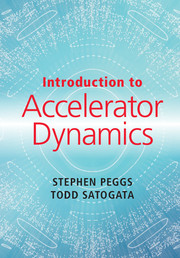Book contents
- Frontmatter
- Dedication
- Contents
- Preface
- 1 Introduction
- 2 Linear Motion
- 3 Strong Focusing Transverse Optics
- 4 Longitudinal and Off-Momentum Motion
- 5 Action and Emittance – One Particle or Many?
- 6 Magnets
- 7 RF Cavities
- 8 Linear Errors and Their Correction
- 9 Sextupoles, Chromaticity and the Hénon Map
- 10 Octupoles, Detuning and Slow Extraction
- 11 Synchrotron Radiation – Classical Damping
- 12 Synchrotron Radiation – Quantum Excitation
- 13 Linacs – Protons and Ions
- 14 Linacs – Electrons
- 15 The Beam–Beam Interaction and 1-D Resonances
- 16 Routes to Chaos
- Appendix A Selected Formulae for Accelerator Design
- References
- Index
16 - Routes to Chaos
Published online by Cambridge University Press: 08 August 2017
- Frontmatter
- Dedication
- Contents
- Preface
- 1 Introduction
- 2 Linear Motion
- 3 Strong Focusing Transverse Optics
- 4 Longitudinal and Off-Momentum Motion
- 5 Action and Emittance – One Particle or Many?
- 6 Magnets
- 7 RF Cavities
- 8 Linear Errors and Their Correction
- 9 Sextupoles, Chromaticity and the Hénon Map
- 10 Octupoles, Detuning and Slow Extraction
- 11 Synchrotron Radiation – Classical Damping
- 12 Synchrotron Radiation – Quantum Excitation
- 13 Linacs – Protons and Ions
- 14 Linacs – Electrons
- 15 The Beam–Beam Interaction and 1-D Resonances
- 16 Routes to Chaos
- Appendix A Selected Formulae for Accelerator Design
- References
- Index
Summary
The standard map emerges when the differential equation of a pendulum is translated to a pair of difference equations, as shown in the discussion of longitudinal motion and synchrotron oscillations in Section 4.4. Its only control parameter, Q0, is analogous to the synchrotron tune of small oscillations in a storage ring with a single RF cavity – or with a set of cavities that are close enough to act as one. The rich phase space behaviour that emerges as Q0 increases is shown in Figure 4.6. A small chaotic area emerges when Q0 = 0.12, easily identifiable as a scattering of dots. Stable resonance islands emerge from a broad chaotic sea in the extreme case with Q0 = 0.18. Stability and chaos are intermingled at all scales – stability within chaos, chaos within stability – ad infinitum. This is what Hofstadter means, when he refers to ‘ … an eerie type of chaos … just behind a facade of order - and yet, deep inside the chaos lurks an even eerier type of order’ [20].
The Hénon map is analogous to a storage ring with a single sextupole, as discussed in Section 9.3. This map generates the rich horizontal behaviour shown graphically in Figure 9.3. The taxonomy of 1-D motion discussed in Section 9.4 categorises turn-by-turn phase space trajectories as:
1. Regular non-resonant;
2. Rapidly divergent;
3. Regular resonant; or
4. Chaotic.
This taxonomy is universal. It emerges in phase space motion driven by one sextupole or many, by beam–beam interactions, or by RF cavities.
Much of this book addresses practical and quantitative aspects of linear and nearlinear regular non-resonant (non-chaotic) motion. Rapidly divergent trajectories are discussed semi-quantitatively in Chapter 10, in the practical context of slow extraction from a storage ring. Regular resonant motion is discussed and quantified in Chapter 15, using the convenient and fundamental example of the 1-D beam– beam interaction.
Chaos can also be predicted and discussed semi-quantitatively, beyond the qualitative observation that it appears as dots in phase space, and beyond its formal definition using Lyapunov exponents. The routes to chaos examined in this chapter inevitably require more than just one real-space dimension, especially when more practical and realistic situations are addressed.
- Type
- Chapter
- Information
- Introduction to Accelerator Dynamics , pp. 181 - 190Publisher: Cambridge University PressPrint publication year: 2017



